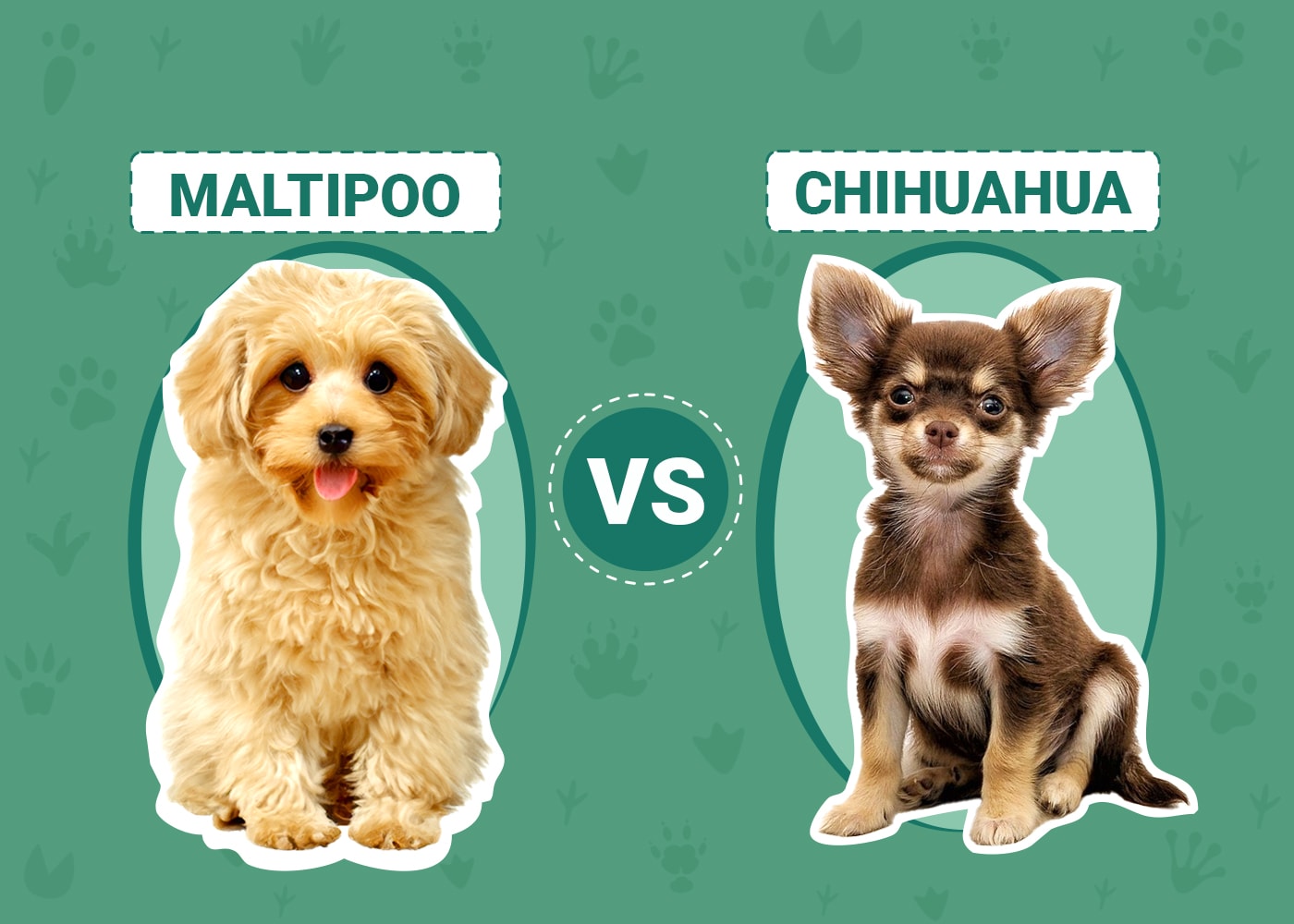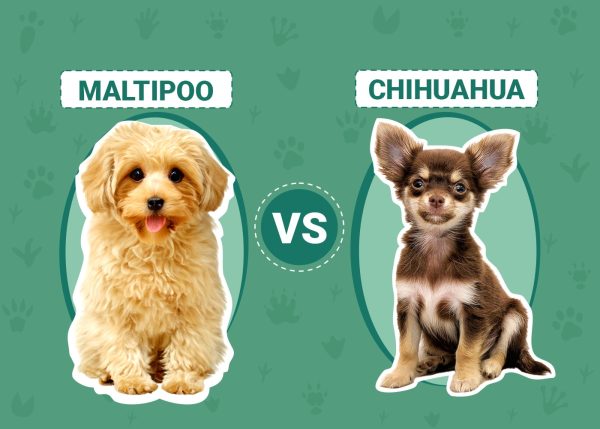Deciding to bring home a new dog makes for an exciting time. Dogs have a way of capturing our hearts and becoming part of the family. This isn’t a commitment to take lightly though, there are a lot of factors that go into dog ownership, including finding the right breed for you and your family.
There are many small dog breeds to choose from, each of which has its unique look and traits. If you are trying to decide between the fluffy, loveable Maltipoo and the cute and cuddly Chihuahua, we’ve got you covered. Here, we will do a side-by-side comparison of the breeds to see which would be most suitable for you.

Visual Differences
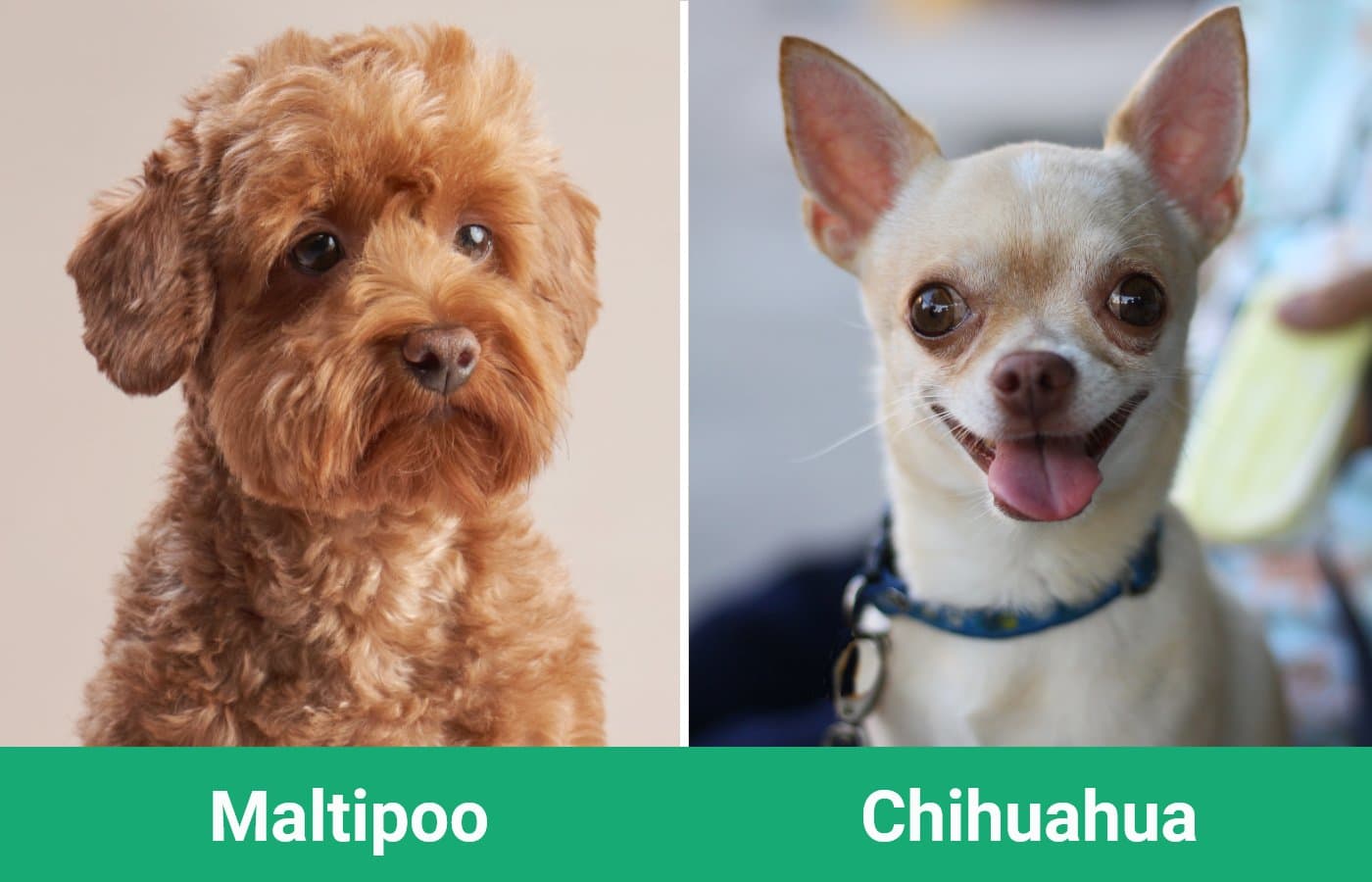
At a Glance
- Average height (adult): 8 – 14 inches
- Average weight (adult): 5 – 20 pounds
- Lifespan: 10 – 13 years
- Exercise: 40 minutes per day
- Grooming needs: High maintenance
- Family-friendly: Yes
- Other pet-friendly: Often
- Trainability: Easy
- Average height (adult): 5 – 8 inches
- Average weight (adult): 3 – 6 pounds
- Lifespan: 14 – 16 years
- Exercise: Up to 30 minutes per day
- Grooming needs: Mild
- Family-friendly: Occasionally
- Other pet-friendly: Not very often
- Trainability: Difficult

Maltipoo Overview
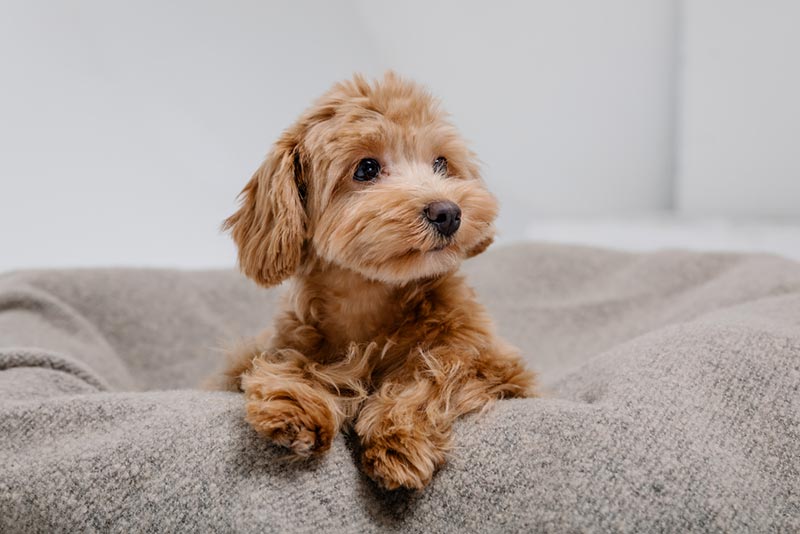
About the Breed
The Maltipoo is a designer hybrid dog breed that is a cross between the Maltese and the Toy Poodle. They were first bred in the 1990s as a low-maintenance companion breed that would be great for both first-time dog owners and allergy sufferers.
Crossbreeding these two beloved toy breeds gives the Maltipoo the best of both parent breeds. Both the Maltese and the Toy Poodle have hair, rather than fur, which results in much less shedding and dander. While no dog can be considered fully hypoallergenic, the fact that they produce less dander makes them an ideal choice for those allergic to dogs.
These dogs continue to grow in popularity due to their small size, lovable nature, and adorable looks. Because they are a hybrid, they do not have any official recognition as a breed by any of the national kennel clubs.
Personality / Character
Maltipoos are known for their wonderful temperaments that blend the traits of both parent breeds. They are excellent companions that have a very gentle, affectionate nature. These total love bugs have big personalities, lots of energy, and a bit of sass.
They will love snuggling up on the laps of their owner just as much as they’ll enjoy daily walks and a dose of exciting playtime. This designer breed is very intelligent and eager to please. They can make great family dogs and typically do very well with children and other pets, especially if introduced properly and socialized from a young age.
Expect a built-in alarm system if you have a Maltipoo, as these dogs will bark quite a bit. It’s like having a cute cuddly watchdog, rather than a large, intimidating one.
Maltipoos are very sensitive to the energy around them, so a home that is full of stress and chaos can severely affect them. They crave human companionship and often suffer from separation anxiety, so they should not be left alone for long periods.

Exercise
The Maltipoo can have quite a bit of energy and will sometimes bounce off the walls. It’s a good idea to set aside around 40 minutes per day to dedicate to their exercise needs. They’ll do perfectly fine on a daily walk or with some quality playtime. Like other toy breeds, they don’t require a lot of space to get their workout in.
Training
Since Maltipoos are very intelligent and eager to please, they are generally easier to train than a lot of other small dog breeds. They make a good choice for first-time owners or those that lack the firm hand that other breeds may require.
This is a breed that will learn quickly and easily but potty training will typically be a hurdle. As with any small dogs, they have smaller bladders and need to go to the bathroom more often. Potty training can take a while, so it will require patience and consistency.
Grooming & Care
Since this breed is a combo between the Maltese and the Toy Poodle, they have more high-maintenance grooming needs than your average dog. They have fast-growing hair and will require frequent grooming. It is recommended that these dogs be brushed once daily, or at least several times per week to keep their coat healthy and mat free. Professional grooming is typically done once every 6 to 8 weeks.
Be prepared to wipe the eyes regularly to prevent tear staining. The ears should be checked regularly for any dirt, debris, or signs of infection. Teach them at a young age to tolerate nail clippings so that you can keep up with those growing claws.
The Maltipoo is small and fragile, so gentle handling is a must. They have the potential to do well in a home with small children if there is constant supervision, but typically do best in households where all members of the family know how to handle them delicately.
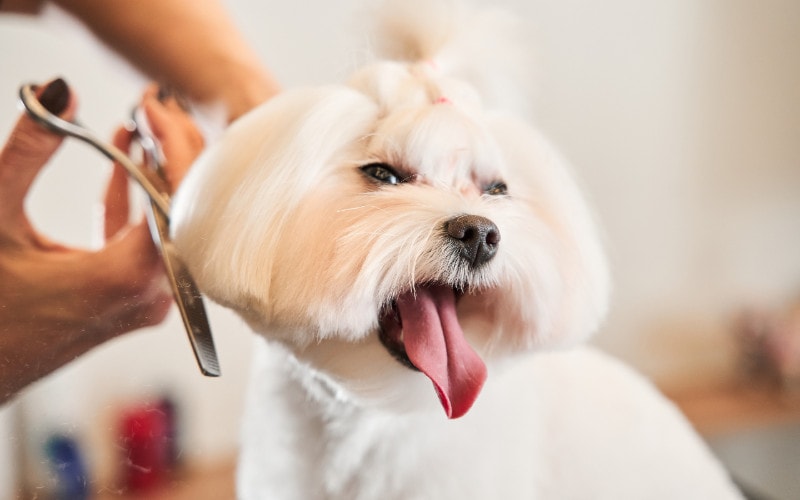
Health
A high-quality, well-balanced diet that is suitable for their size, age, and activity level should be a top priority for optimal health. The Maltipoo is typically a healthy little dog with less predisposition to inherited conditions when compared to the purebred parent breeds. That doesn’t exempt them from having a few common health problems though.
Suitable for:
Overall, the Maltipoo is a great choice of small breed for first-time dog owners or anyone looking for a happy, loving toy breed. Since they crave constant companionship, this isn’t an ideal dog for a busy household that is in and out all the time. They are most suitable for those that are home more often than not.
This hybrid breed is excellent for allergy sufferers, the elderly, apartment dwellers, and families that have both the ability and time to devote to their specific needs. Of course, early socialization is key to having the most balanced, well-behaved dog.
- Ideal for allergy sufferers
- Great with children, seniors, and other pets
- Intelligent and easy to train
- Loyal and loving
- Prone to fewer genetic health conditions
- Does not require a lot of space
- Prone to separation anxiety
- High-maintenance grooming needs
- Difficult to housetrain
- Excessive barking
- Requires gentle handling

Chihuahua Overview
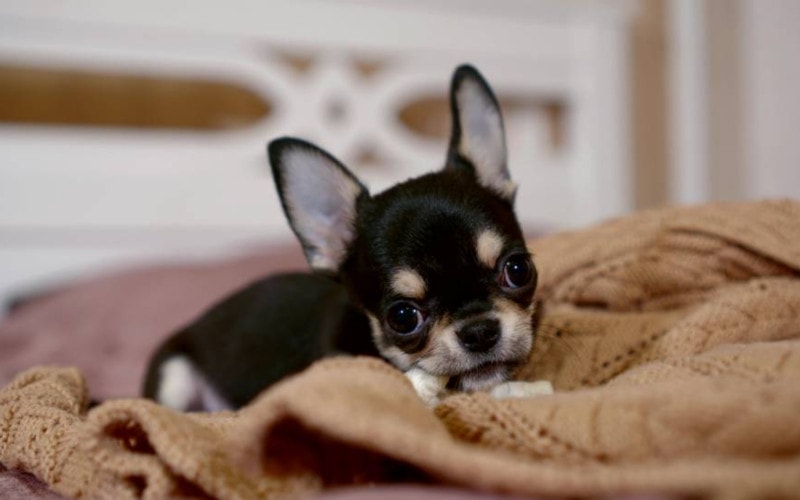
About the Breed
It’s well known that the Chihuahua originated in Mexico, but how they first got there remains unknown. They are believed to have evolved from the Techichi, which was a larger version of the modern-day Chihuahua that was popular among the Toltecs.
When the Aztecs defeated the Toltecs, the breed was transformed into a lighter, smaller version. The Aztec civilization collapsed in the 1500s, but these little dogs did not. Americans came across the breed in the Mexican state of Chihuahua around the mid-1800s and by 1904, the breed was recognized by the American Kennel Club.
Since then, the Chihuahua has maintained its status as one of the most popular toy breeds. They are featured throughout pop culture and have a reputation for being small, but fierce. They come in both short coats and long coats with a wide variety of colors, markings, and head shapes.
Personality / Character
Chihuahuas are a lot of dog in a very small package. They are a loyal and loving breed that enjoys being with their people. They do have a bit of a feisty streak, so expect to be met with a sassy attitude. They are also energetic, active, playful, and quite entertaining.
Their temperaments vary depending on the individual, ranging from timid to very friendly. Many Chihuahuas are prone to anxiousness and separation anxiety and should be properly socialized from a young age.
This breed is highly alert, barks a lot, and is very cautious of strangers. You can expect to be notified if anything out of the ordinary is going on. Because they tend to be domineering, they aren’t the best with other dogs or small children, but they typically do well with cats.
This breed is one of the top chewers, so items will need to be picked up and precautions will need to be taken. The Chihuahua is a combination of sweet and doting mixed with some sassy stubbornness. They might just be the reason that “Small Dog Syndrome” was coined as a term.
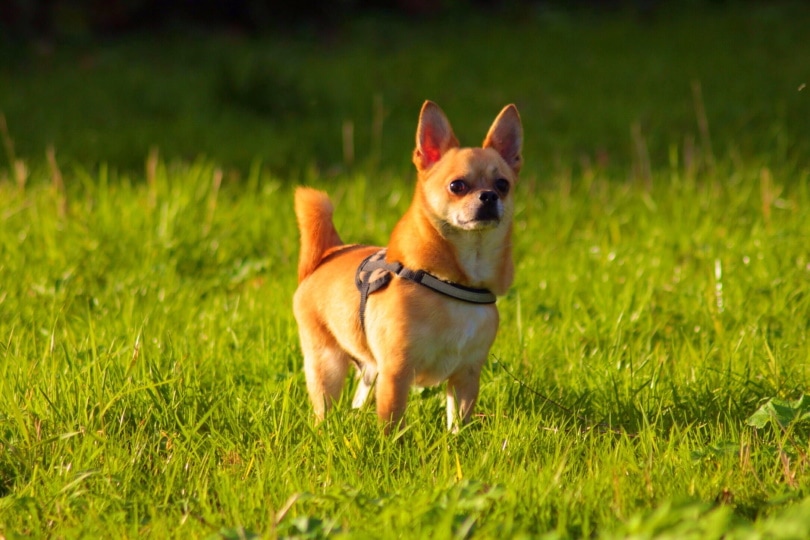
Exercise
The Chihuahua’s size leaves them with minimal space requirements, so they don’t need a lot of room to get in their daily dose of exercise. It’s typically recommended that they get in around 30 minutes of activity per day. Since they are already an active breed, they will typically use the house as their playground, so don’t be surprised when they dart around the house in a frenzy.
Training
Chihuahuas are an alert and intelligent breed that will use their smarts against you. They may be tiny, but they have very big egos and can be a bit difficult to train. Chihuahuas are very well known for having Small Dog Syndrome, which means they are convinced they are your boss, not the other way around.
This breed thrives on positive reinforcement and reward-based training. This will need to start right from the get-go to battle their alpha dog ways. They will typically pick up on tricks quite easily and can even excel in certain canine sports.
Owners must remain firm and consistent with training and not let the Chihuahua get away with anything inappropriate. It’s also highly recommended that proper socialization starts early and continues through adulthood.
Expect potty training to be an obstacle. These dogs are known for being one of the most difficult to potty train, not just because they have small bladders but because they are notoriously stubborn and prefer to do as they please.
Grooming & Care
Since there are both short-coated and long-coated Chihuahuas, grooming needs vary depending on which coat type you have. Short-coated Chihuahuas are very low maintenance when it comes to grooming and will do well with regular brushing to remove any loose hairs. Long-coated individuals will need to be brushed more often to keep their coats from becoming tangled or matted.
This breed will shed all year round, but you may notice it gets worse in the spring and fall. Start with regular nail trimmings, ear checks, and eye wiping when they are puppies. That way, they are used to this type of care, and they remain calm and cooperative during the process.
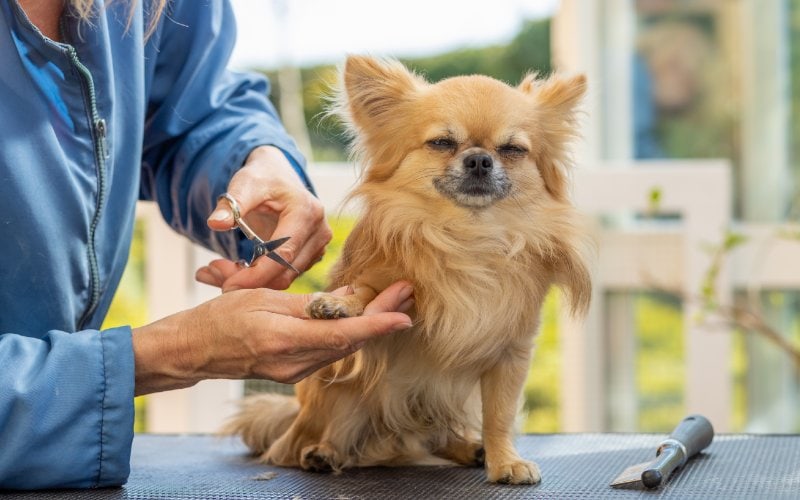
Health
Like any dog, the Chihuahua should be fed an appropriate diet that is high-quality and suitable for their age, size, and activity level. Nutrition plays a vital role in overall health and wellness. Chihuahuas are generally healthy little dogs that have longer than average lifespans.
They are very sensitive to the cold, so owners will need to take extra steps to keep them warm, especially during the winter months. As with purebreds, there are certain genetic health conditions to watch out for.
Suitable for:
The Chihuahua is best suited for the elderly, families with older children, and households without other dogs, especially larger ones. It’s not that Chihuahuas cannot live harmoniously with bigger dogs but because of their need for dominance and tendency to antagonize, it can put them at severe risk of injury or death if an altercation were to ensue.
These loving little pocket dogs will do well in a household where their person is home the majority of the time or for those that like to bring their dog along on their adventures. They are also great apartment pets because they don’t require a lot of space. Potential Chihuahua owners should be prepared for the training challenges and specific needs that come with the breed.
- Loving and devoted
- Longer than the average lifespan
- Easy to groom
- Minimal space requirements
- Playful and energetic
- Easy to travel with
- Intelligent and alert
- Very delicate
- Feisty and prone to nipping
- Stubborn and difficult to train
- Not great with other dogs
- Prone to chewing
- Excessive barking
- Sensitive to cold
- Prone to more health conditions

Which Breed Is Right for You?
The Maltipoo and the Chihuahua do have some similarities, but there are also plenty of differences that could be the deciding factor in making your final choice. Both breeds are small, delicate, and require gentle handling. Both are very loving, cuddly, and loyal to their people and tend to bark a lot.
Maltipoos are typically easier to train than Chihuahuas, though both can be difficult with housetraining. Maltipoos have more extensive grooming needs but are better for allergy sufferers while Chihuahuas are fairly low maintenance in that department but produce more dander.
Chihuahuas aren’t as ideal for families with children or other dogs because they like to rule the roost and can get nippy and aggressive. Maltipoos can exhibit a sassy nature too, but they are generally easier going and good with children and all other pets if properly trained and socialized.
Only you can decide which breed is right for you since you are aware of what you are looking for out of a dog. Overall, they both make excellent little companion dogs when placed in a compatible home.
Featured Image Credit: (Top) Irsan Ianushis, Shutterstock | (Bottom) Jairo Alzate, Unsplash

